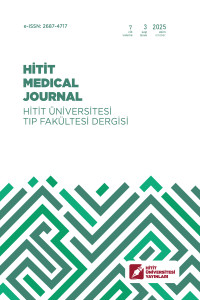Abstract
Amaç: Bu çalışmanın amacı, erişkin intussusception olgularında BT’nin tanı, etiyoloji ve hastalığın ciddiyetini belirlemedeki rolünü değerlendirmektir.
Gereç ve Yöntem: Çalışmaya cerrahi olarak doğrulanmış erişkin intussusception tanılı 19 hasta dahil edildi. Hastaların demografik verileri, BT bulguları, intussusception segmentinin uzunluğu, transvers çapı, lead point varlığı ve obstrüksiyon durumu değerlendirildi.
Bulgular: Hastaların yaş ortalaması 57,1 ± 14,1 yıl idi. En sık tutulan segment ileum (%57,9) olarak belirlendi. Olguların %94,7’sinde BT ile lead point saptandı; en sık görülen lezyon lipom idi. Malign lezyon oranı %21,1 olup, bu oran literatür ile uyumluydu. Obstrüksiyon saptanan olgularda transvers çap anlamlı olarak daha genişti (p = 0,002). Segment uzunluğu obstrüksiyon grubunda daha fazla olmasına rağmen istatistiksel olarak anlamlı bulunmadı (p = 0,052).
Sonuç: BT, erişkin intussusception olgularında yalnızca tanı koymakla kalmayıp, lead point varlığı ve obstrüksiyon gibi parametreler yoluyla hastalığın ciddiyeti hakkında da bilgi sağlamaktadır. Transvers çap ve segment uzunluğu gibi BT temelli ölçümlerin klinik yönetimde öngörücü olabileceği düşünülmektedir. Bu bulguların daha büyük ve prospektif çalışmalarla desteklenmesi gerekmektedir.
References
- Marinis A, Yiallourou A, Samanides L, et al. Intussusception of the bowel in adults: a review. World J Gastroenterol 2009;15(4):407-411.
- Azar T, Berger DL. Adult intussusception. Ann Surg 1997;226(2):134-138.
- Agha FP. Intussusception in adults. AJR Am J Roentgenol 1986;146(3):527-531.
- Park SB, Ha HK, Kim AY, et al. The diagnostic role of abdominal CT imaging findings in adults intussusception: focused on the vascular compromise. Eur J Radiol 2007;62(3):406-415.
- Kim YH, Blake MA, Harisinghani MG, et al. Adult intestinal intussusception: CT appearances and identification of a causative lead point. Radiogr Rev Publ Radiol Soc N Am Inc 2006;26(3):733-744.
- Tresoldi S, Kim YH, Blake MA, et al. Adult intestinal intussusception: can abdominal MDCT distinguish an intussusception caused by a lead point? Abdom Imaging 2008;33(5):582-588.
- Begos DG, Sandor A, Modlin IM. The diagnosis and management of adult intussusception. Am J Surg 1997;173(2):88-94.
- Lamki N, Woo CL, Watson AB, Kim HS. Adenomyomatous hamartoma causing ileoileal intussusception in a young child. Clin Imaging 1993;17(3):183-185.
- Mansberg VJ, Mansberg G, Doust BD. Jejunojejunal intussusception secondary to leiomyoma. Australas Radiol 1996;40(1):72-74.
- Boudiaf M, Soyer P, Terem C, Pelage JP, Maissiat E, Rymer R. CT evaluation of small bowel obstruction. Radiogr Rev Publ Radiol Soc N Am Inc 2001;21(3):613-624.
- Wong L, Sivanesan U, Haider M, Chung AD. Intraluminal causes of mechanical small bowel obstruction: CT findings and diagnostic approach. Eur J Radiol 2025;187:112115.
Abstract
Objective: This study aimed to characterize computed tomography (CT) imaging features of adult intussusception, identify underlying lead points, and correlate morphological findings (segment length, transverse diameter) with clinical presentation.
Materials and Methods: Nineteen surgically confirmed adult intussusception cases were retrospectively analyzed. Demographic data, CT findings, intussuscepted segment length, transverse diameter, presence of a lead point, and obstruction status were recorded.
Results: The mean patient age was 57.1 ± 14.1 years. The ileum was the most commonly affected segment (57.9%). A lead point was identified on CT in 94.7% of cases, with lipoma being the most frequent lesion. Malignant lesions were found in 21.1% of patients, consistent with the literature. Transverse diameter was significantly greater in cases with obstruction (p = 0.002). Although segment length was higher in the obstruction group, the difference was not statistically significant (p = 0.052).
Conclusion: CT is not only effective in diagnosing adult intussusception but also provides valuable information on its etiology and severity through parameters such as lead point detection and signs of obstruction. CT-derived measurements like transverse diameter and segment length may have predictive value in clinical decision-making. Further large-scale, prospective studies are needed to validate these findings.
References
- Marinis A, Yiallourou A, Samanides L, et al. Intussusception of the bowel in adults: a review. World J Gastroenterol 2009;15(4):407-411.
- Azar T, Berger DL. Adult intussusception. Ann Surg 1997;226(2):134-138.
- Agha FP. Intussusception in adults. AJR Am J Roentgenol 1986;146(3):527-531.
- Park SB, Ha HK, Kim AY, et al. The diagnostic role of abdominal CT imaging findings in adults intussusception: focused on the vascular compromise. Eur J Radiol 2007;62(3):406-415.
- Kim YH, Blake MA, Harisinghani MG, et al. Adult intestinal intussusception: CT appearances and identification of a causative lead point. Radiogr Rev Publ Radiol Soc N Am Inc 2006;26(3):733-744.
- Tresoldi S, Kim YH, Blake MA, et al. Adult intestinal intussusception: can abdominal MDCT distinguish an intussusception caused by a lead point? Abdom Imaging 2008;33(5):582-588.
- Begos DG, Sandor A, Modlin IM. The diagnosis and management of adult intussusception. Am J Surg 1997;173(2):88-94.
- Lamki N, Woo CL, Watson AB, Kim HS. Adenomyomatous hamartoma causing ileoileal intussusception in a young child. Clin Imaging 1993;17(3):183-185.
- Mansberg VJ, Mansberg G, Doust BD. Jejunojejunal intussusception secondary to leiomyoma. Australas Radiol 1996;40(1):72-74.
- Boudiaf M, Soyer P, Terem C, Pelage JP, Maissiat E, Rymer R. CT evaluation of small bowel obstruction. Radiogr Rev Publ Radiol Soc N Am Inc 2001;21(3):613-624.
- Wong L, Sivanesan U, Haider M, Chung AD. Intraluminal causes of mechanical small bowel obstruction: CT findings and diagnostic approach. Eur J Radiol 2025;187:112115.
Details
| Primary Language | English |
|---|---|
| Subjects | Radiology and Organ Imaging |
| Journal Section | Research Articles |
| Authors | |
| Publication Date | October 13, 2025 |
| Submission Date | June 4, 2025 |
| Acceptance Date | August 18, 2025 |
| Published in Issue | Year 2025 Volume: 7 Issue: 3 |
Hitit Medical Journal is licensed under a Creative Commons Attribution-NonCommercial 4.0 International License (CC BY NC).

